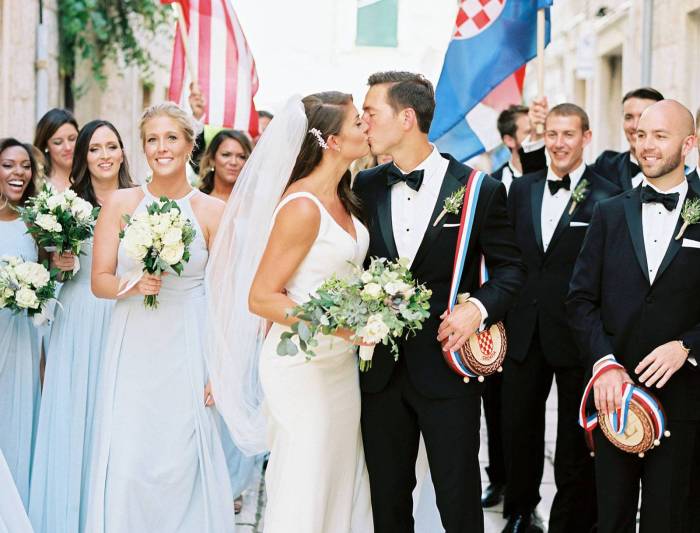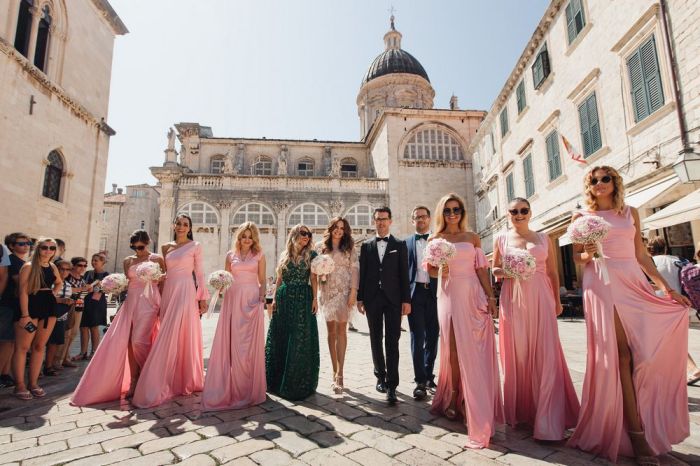Design Trends in Baltic-Born Wedding Dresses
Baltic born wedding dresses – Baltic wedding dresses, often overlooked in the global bridal landscape, offer a unique blend of traditional craftsmanship and modern design sensibilities. These gowns showcase a fascinating interplay of history, culture, and contemporary aesthetics, resulting in breathtakingly unique pieces. Let’s delve into the captivating world of Baltic bridal fashion.
Prevalent Silhouettes and Styles
Baltic-born wedding dresses frequently feature A-line and empire waist silhouettes, flattering a wide range of body types. While some designs lean towards a more traditional, fitted style, others embrace a flowing, romantic aesthetic. Lace, often hand-crafted, is a recurring motif, adding a touch of delicate elegance. The overall style often reflects a sense of understated sophistication, avoiding overly fussy details.
Common Fabrics and Their Significance
Linen, silk, and lace are staples in Baltic wedding dress construction. Linen, a durable and breathable fabric, reflects the region’s connection to nature and its agricultural heritage. Silk adds a touch of luxurious sheen and elegance, while lace, often intricately embroidered, represents the meticulous craftsmanship passed down through generations. The choice of fabric often reflects both the bride’s personal style and the specific traditions of her region.
Typical Embellishments and Embroidery
Intricate embroidery, often featuring floral motifs or symbolic patterns, is a hallmark of Baltic wedding dresses. These embellishments are not merely decorative; they often carry cultural significance, representing good fortune, fertility, or protection. Beading and delicate appliqués are also commonly used, adding subtle sparkle and texture. The level of embellishment can vary widely, ranging from simple yet elegant details to heavily adorned gowns.
Comparison with Other European Regions
Compared to the often more flamboyant styles of Southern European wedding dresses, Baltic designs tend towards a more restrained elegance. While some similarities exist with Scandinavian designs in their minimalist approach, Baltic gowns often incorporate richer embroidery and more elaborate detailing. The use of linen, a fabric less common in other European bridal traditions, further distinguishes Baltic wedding dresses.
Comparative Table of Baltic Wedding Dress Characteristics
| Country | Silhouette | Fabric | Embellishment |
|---|---|---|---|
| Latvia | A-line, Empire waist | Linen, Lace | Floral embroidery, beading |
| Lithuania | Fitted, A-line | Silk, Linen blends | Intricate embroidery, appliqués |
| Estonia | Flowing, Bohemian | Lace, Cotton | Delicate embroidery, ribbon accents |
Historical Influences on Baltic Wedding Dress Design

Source: l-media.net
The evolution of Baltic wedding dress styles is a rich tapestry woven from centuries of tradition and cultural exchange. Understanding this history provides a deeper appreciation for the unique character of contemporary designs.
Evolution of Baltic Wedding Dress Styles
Baltic wedding attire has undergone significant transformations throughout history, reflecting the region’s complex past. Early designs were often simpler, focusing on practicality and functionality. The influence of neighboring cultures, such as those of Scandinavia and Central Europe, is evident in the gradual incorporation of new fabrics, silhouettes, and embellishments over time. The rise of industrialization and globalization also played a significant role, introducing new materials and manufacturing techniques.
Cultural and Traditional Elements
Traditional elements, such as symbolic embroidery patterns representing fertility or prosperity, continue to inspire contemporary designers. The use of natural fabrics like linen and the incorporation of handcrafted details are also testaments to the enduring influence of Baltic heritage. These traditions are often subtly integrated into modern designs, adding a layer of cultural richness and meaning.
Baltic-born wedding dresses often feature intricate embroidery and traditional silhouettes, reflecting regional heritage. For a more contemporary approach to guest attire, exploring options like those available from asos dresses wedding guest might offer a wider range of styles. Ultimately, the choice depends on the desired level of formality and personal preference, but both offer unique aesthetic considerations.
Impact of Significant Historical Events

Source: studiodt.com
Major historical events, including periods of war and occupation, significantly impacted Baltic fashion. Periods of hardship often led to simpler styles, while times of relative prosperity allowed for more elaborate designs. The interplay between tradition and adaptation in the face of historical change is a fascinating aspect of Baltic wedding dress history.
Examples of Traditional Garments and Their Symbolism
Traditional Baltic wedding garments often featured intricate embroidery with symbolic meanings. For example, floral motifs could represent fertility and abundance, while geometric patterns might symbolize protection or good luck. The colors used also held significance, with certain shades associated with specific beliefs or traditions. These symbolic elements are often subtly incorporated into modern designs, adding a layer of cultural depth.
Historical Evolution in a Bulleted List
- Pre-20th Century: Primarily simple, functional designs using locally sourced materials. Emphasis on practicality and symbolism through embroidery.
- Early 20th Century: Influence of Art Nouveau and other European styles. Introduction of new fabrics and embellishments.
- Mid-20th Century: Simpler styles due to wartime restrictions. Focus on functionality and resourcefulness.
- Late 20th and Early 21st Century: Revival of traditional elements combined with modern design sensibilities. Emphasis on individuality and cultural heritage.
Modern Interpretations of Traditional Baltic Wedding Dresses
Contemporary designers are skillfully reinterpreting traditional Baltic elements, creating modern wedding dresses that honor heritage while embracing contemporary aesthetics. This fusion of old and new results in stunningly unique and stylish gowns.
Contemporary Reinterpretations of Traditional Elements
Modern designers often incorporate traditional Baltic embroidery patterns into contemporary silhouettes, creating a harmonious blend of old and new. The use of natural fabrics like linen and silk, while often updated with modern production techniques, remains a common thread. This approach allows for a respectful nod to heritage without sacrificing modern style.
Innovative Design Choices
Innovative design choices include the incorporation of unexpected textures and colors, while maintaining the essence of Baltic heritage. Asymmetrical designs, unexpected sleeve details, and the use of unconventional embellishments are all examples of modern interpretations. These choices add a contemporary edge without compromising the inherent elegance of Baltic-inspired designs.
Examples of Modern Baltic-Inspired Wedding Dresses
Imagine a gown with a flowing A-line silhouette crafted from ivory linen, adorned with delicate floral embroidery inspired by traditional Baltic patterns. Another example might be a fitted crepe gown with intricate lace detailing on the sleeves and back, echoing the meticulous craftsmanship of historical Baltic garments. These designs showcase a sophisticated blend of tradition and modernity.
Fusion of Traditional and Modern Elements
The most successful modern Baltic-inspired wedding dresses seamlessly blend traditional elements with contemporary design sensibilities. The result is a collection of gowns that are both timeless and strikingly modern, reflecting the rich heritage of the Baltic region while appealing to the discerning tastes of contemporary brides.
Fictional Modern Baltic-Inspired Wedding Dress
Envision a flowing A-line gown crafted from a luxurious silk blend in a soft blush pink. The bodice features intricate hand-embroidered floral patterns inspired by traditional Latvian designs, while the skirt flows gracefully to the floor. Delicate seed pearls accentuate the embroidery, adding a touch of subtle sparkle. The overall aesthetic is one of romantic elegance, subtly referencing Baltic heritage while embracing a contemporary, feminine silhouette.
The Role of Sustainability and Ethical Practices in Baltic Wedding Dress Production: Baltic Born Wedding Dresses
Increasingly, brides are seeking wedding dresses that reflect their values, including sustainability and ethical production. The Baltic region, with its rich history of craftsmanship and connection to nature, is well-positioned to lead the way in this area.
Sustainable Materials and Ethical Production
Many Baltic designers are embracing sustainable materials like organic linen and ethically sourced silk. They prioritize fair labor practices and minimize waste throughout the production process. This commitment to sustainability reflects a growing awareness of the environmental impact of the fashion industry and a desire to create beautiful gowns with minimal negative consequences.
Brands Committed to Sustainable and Ethical Practices
While a comprehensive list requires further research, several smaller, independent Baltic designers are leading the charge in sustainable bridal wear. These designers often focus on local production, reducing transportation emissions and supporting local communities. They often highlight their commitment to sustainability through transparent sourcing and production practices.
Environmental Impact and Potential Solutions, Baltic born wedding dresses
The wedding dress industry, like many sectors of fashion, has a significant environmental impact. The use of unsustainable materials, energy-intensive manufacturing processes, and excessive waste all contribute to this impact. Solutions include prioritizing sustainable materials, reducing waste through innovative design and production techniques, and promoting responsible consumption practices.
Comparison of Sustainability Practices
A direct comparison of sustainability practices across all Baltic designers would require extensive research. However, it’s likely that smaller, independent designers are more likely to prioritize sustainable and ethical practices than larger, mass-production brands. This highlights the importance of supporting smaller businesses committed to these values.
Tips for Brides Seeking Sustainable and Ethically Produced Dresses
- Research designers and brands known for their commitment to sustainability and ethical production.
- Look for certifications and labels that verify sustainable materials and ethical practices.
- Inquire about the sourcing and production process of the dress.
- Consider purchasing a pre-owned or vintage wedding dress.
- Support designers who prioritize transparency and accountability.
Illustrative Examples of Baltic-Born Wedding Dresses
To fully appreciate the diversity and artistry of Baltic-born wedding dresses, let’s explore some specific examples, highlighting their unique design elements and the emotions they evoke.
Three Distinct Baltic-Born Wedding Dresses
Dress 1: Imagine a flowing A-line gown in a soft ivory linen, adorned with delicate hand-embroidered wildflowers. The subtle texture of the linen creates a feeling of rustic elegance, while the wildflowers evoke a sense of natural beauty and understated romance. The color palette is kept simple, emphasizing the beauty of the natural materials.
Dress 2: Picture a fitted silk crepe gown in a deep blush pink, featuring intricate lace sleeves and a low back. The lace is meticulously crafted, adding a touch of vintage glamour. The overall feeling is one of sophisticated femininity, with a hint of old-world charm. The rich pink color adds a touch of warmth and vibrancy.
Dress 3: Envision a bohemian-inspired gown made from a lightweight cotton blend in a creamy off-white. Delicate embroidery in muted greens and blues adorns the bodice and sleeves, creating a sense of ethereal lightness and effortless beauty. The dress evokes a feeling of carefree elegance, perfect for a relaxed yet stylish celebration.
Two More Distinct Baltic-Born Wedding Dresses
Dress 4: This gown, inspired by traditional Lithuanian designs, features a fitted bodice with a full skirt. The fabric is a heavy linen, hand-woven in a muted grey, symbolizing the resilience of the Baltic spirit. Intricate geometric embroidery, representing good fortune, adorns the bodice. The construction techniques are traditional, highlighting the skill and heritage of the region.
Dress 5: Inspired by Estonian folk costumes, this dress boasts a flowing A-line silhouette in a deep navy blue linen. The bodice features a high neckline and long sleeves, embellished with delicate red and white embroidery, symbolic of Estonian national colors. The construction is based on traditional techniques, showcasing the craftsmanship of the region. The overall feeling is one of dignified elegance, deeply rooted in Estonian heritage.
FAQ Section
What are the typical price ranges for Baltic-born wedding dresses?
Price varies greatly depending on designer, materials, and embellishments. Expect a range from moderately priced to high-end luxury, comparable to other European designer gowns.
Where can I find Baltic-born wedding dresses to purchase?
Some designers may have online stores, while others may be found through bridal boutiques specializing in international designers. Attending bridal shows in Baltic countries or contacting designers directly is also an option.
Are alterations readily available for Baltic-born wedding dresses?
Yes, most reputable designers or boutiques offering these dresses will provide alteration services to ensure a perfect fit. It’s advisable to factor alteration costs into your budget.
How long is the typical lead time for a custom-made Baltic-born wedding dress?
Lead times vary depending on the designer and the complexity of the design. Allow at least six months, and potentially longer for highly intricate designs or during peak seasons.
